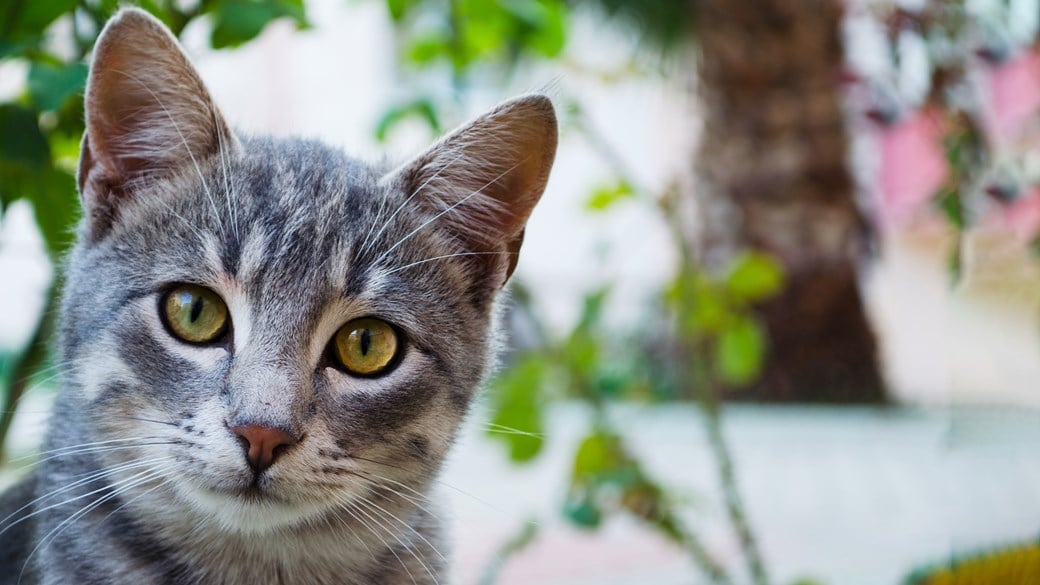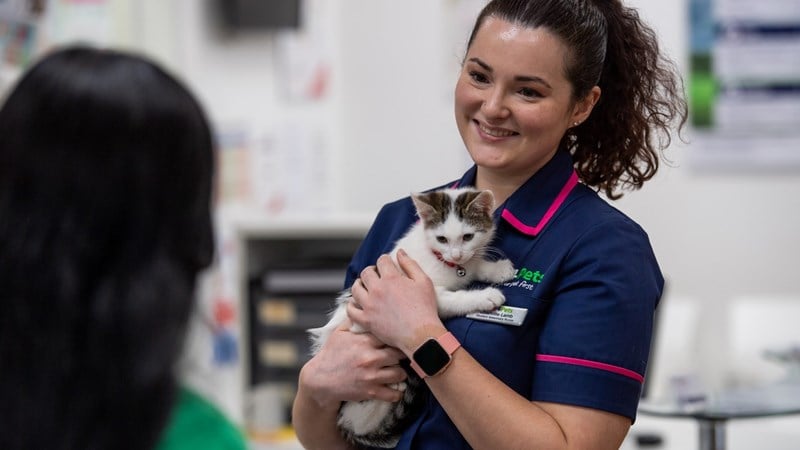
Cat Diabetes Advice & Care
How to handle feline diabetes.
Diabetes mellitus, the most common form of diabetes, is caused by a problem with the production and efficacy of a hormone called insulin. Finding out your cat has diabetes can be quite a shock. Understanding the disease can help better grasp the different options available for cat diabetes treatment.
This long-term condition can be managed and affected cats can have a very good quality of life, but management can be complex and has to be tailored to your individual cat. Although this can seem daunting, your vet and all the team at your local Vets4Pets can help.
While all cats have the potential to develop diabetes, some cats are at higher risk.
Feline diabetes is more commonly seen in middle aged or elderly cats, and has a higher prevalence in male cats than female cats.
Being overweight is the biggest risk factor for diabetes in cats, as a sedentary lifestyle and obesity can both cause body tissues to become resistant to the effects of insulin.
There may be a genetic component – Burmese cats seem to have a higher prevalence of diabetes than other breeds – however any breed of cat can be affected.
The clinical signs of diabetes in cats include the below, although not all are present in every case:
- Increased thirst
- Increased urination
- Weight loss
- Tiredness
- Weakness in the back legs
- Increased hunger
- Urinary tract infections
These signs can also be associated with other diseases, so it is important for your vet to do some tests to check and see if your cat has diabetes or another condition.
Severe, unmanaged diabetes can lead to a condition called ketoacidosis. This is caused by the body having to rely on ‘ketones’ as a source of energy for the body due to a lack of sugar in the cells. Ketoacidosis can prompt serious signs such as vomiting and collapse and is a veterinary emergency.
Clinical signs are not enough to diagnose a cat with diabetes. This is because these signs can be seen with a number of diseases.
This means your vet will need to conduct tests to confirm diabetes before recommending any treatment. This is a requirement, as giving insulin to a non-diabetic cat could be fatal.
Tests for diabetes:
- Urine test: This looks for sugar in the urine. Normally all sugar is ‘caught’ by the kidneys and kept in the body, but in diabetes the sugar is so high some escapes and can be measured in urine. In the olden days tasting urine to see if it was sweet was a test for diabetes, but thankfully urine testing methods have moved on since then!
- Screening blood test: This measures sugar levels in the blood directly. Screening blood tests can also look for other markers of illness, so your vet can get a good idea of your pet’s general health as well as looking for other diseases.
- Fructosamine: This is a specific blood test that is used in cats that have already been diagnosed with diabetes, or in cases where other tests may be inconclusive. It measures the average blood sugar content over a period of 2-3 weeks. In cats this is especially important as stress can cause blood sugar levels to rise in the short term, even in non-diabetic animals. A fructosamine test confirms that blood sugar levels have been elevated chronically, not just while at the vet clinic!
Insulin FAQs
Insulin is produced by the pancreas and signals cells to absorb glucose (sugar) from blood. This glucose provides energy for the cells.
Insulin is produced whenever blood sugar levels start to rise, normally after meals. This helps keep your cat’s blood sugar levels stable as the insulin moves the sugar from the blood into the cells.
In cats, diabetes is characterised by a combination of a failure to produce adequate insulin and a ‘resistance’ to insulin in body tissues. This can occur naturally, or can be secondary to other factors such as disease, certain drug use or obesity.
Diabetes in cats appears to be very similar to type two diabetes in humans.
Type one diabetes, where the pancreas is destroyed by the immune system, is very rare in cats and is much more commonly seen in dogs.
Cats who cannot produce enough insulin cannot control their blood sugar levels. The levels of sugar in the blood rise to dangerous levels (called hyperglycaemia). Chronically elevated levels of sugar increase the risk of other health problems.
This disease is incurable and can only be managed, however cats who are closely managed and respond well to treatment can live very happy lives.
Managing diabetic cats involves looking at all the factors that can affect their insulin production and insulin response.
Diet
As obesity can lead to resistance to insulin, in some cases getting an overweight cat down to a healthy weight will result in resolution of the diabetes. As well as helping your cat become a healthy weight, giving the right diet can also help manage their diabetes directly. Feeding a low carbohydrate diet can lead to less insulin requirement and can even, in some cases, help diabetes resolve. Specialised diets for diabetic cats have been developed so if your cat will take these this can be very helpful. Your vet can advise on the best nutrition plan for your cat.
Click here for more information about your cat’s healthy weight.
Keeping your cats feeds as regular and routine as possible will also keep their insulin requirements predictable. Try and feed your cat at the same times every day, with the same food, and avoid treats.
Insulin
As most diabetic cats struggle to produce their own insulin giving insulin via injection is the most common way to manage their blood sugar levels. Insulin injections are usually given every 12 hours, immediately after meals, although in some cases cats can be managed by a once daily injection. Your cat’s starting insulin dose will be based on their body weight. Your vet will then monitor your cat’s response to the insulin, making adjustments to the dose until the current optimal dose has been determined. Never change your cat’s insulin dose yourself without speaking to your vet.
This process can take weeks or months, and your cat’s ideal dose may change over time so it’s important to keep having regular check-ups with your vet. Getting the dose right is critical – a too high dose can push your cat’s blood sugar too low, which is very dangerous. Many people find the idea of injecting their cat scary at first. Your vet will spend time with you showing you how to inject your cat – the needle is very fine and most cats don’t react at all!
If you are in any doubt about giving your cat’s insulin, always speak to your vet.
External Factors
Anything that may be affecting the way your cat responds to insulin should be addressed. This includes:
- Any drugs that may be causing diabetes
- Weight
Oral Drugs
There are some tablet medications available for cats with mild diabetes. These are usually not as efficacious as the injections, but may be useful in cats that are impossible to inject.
Monitoring of diabetic cats is done by looking at their blood sugar levels, as well as their clinical signs.
Blood Sugar
Blood sugar levels are measured in two ways:
- A glucometer.
- This measures the blood glucose (sugar) in a drop of blood and is a ‘snapshot’ of the blood glucose level at that moment.
- This is good for doing glucose curves, where blood sugar levels are measured every one to two hours through the day. This shows the peaks and troughs of blood sugar and how levels respond to both eating food and insulin injections.
- Doing these at home, if you feel confident to do so, will also help you monitor your cat’s diabetes as you learn what is ‘normal’ for them.
- Fructosamine.
- This is measured in a small sample of blood to give an average blood sugar level over the previous 2-3 weeks.
- This is a good measure of how controlled blood sugar levels have been
- Both of these tests are useful when assessing a diabetic cat.
Hypoglycaemia
When a pet’s blood glucose levels fall too low this is called hypoglycaemia, a dangerous complication of diabetes.
If your cat’s blood sugar falls too low they may show signs such as:
- Tiredness
- Stumbling
- Drinking and urinating more than usual
- Seizures
- Unconsciousness
Hypoglycaemia can happen when your pet has had too much insulin, or if they do not eat after having received their normal insulin dose.
Keeping high sugar items around, such as glucose powers/gels, is recommended for emergencies as they can be rubbed on the gums and absorbed.
If you think your cat has low blood sugar this is an emergency and you should contact your vet immediately.
What should I do if I'm worried?
Worries about the implications of a cat with diabetes, including cost, commitment to routine and emotional strain are all normal.
Your vet and nursing team are there to support you, as well as provide veterinary care for your cat.
If you have any questions or concerns about your cat’s diabetes and managing it at home, please speak to your vet or nurse who can help with advice, information and support.
If you are worried about your diabetic cat and feel they are behaving abnormally, always contact your practice immediately. They can give you advice and see your cat if they recommend it.
Health Plans to keep your cat healthy
At Vets4Pets we offer a range of Health Plans that make essential routine treatments more affordable. You'll save money on things like annual vaccinations, flea and worm treatment and routine health check-ups.

Cat Advice
Read more of our expert cat advice to keep your cat happy and healthy.
